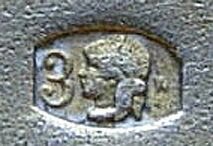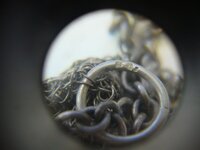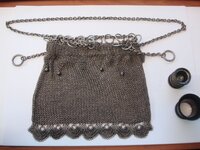UnderMiner
Silver Member
- Jul 27, 2014
- 3,818
- 9,726
- 🥇 Banner finds
- 2
- Detector(s) used
- Minelab Excalibur II, Ace 250
- Primary Interest:
- All Treasure Hunting
Back in September I found a broken sterling silver mirror and a cool looking chainmail bag at the dump.
This is the original post: http://www.treasurenet.com/forums/t...0-s-sterling-silver-mirror-chainmail-bag.html
I initially had trouble determining if the mirror was silver or not but I discovered it had an English Sterling hallmark on it before I posted the story to Treasurenet. What I didn't know however was that the cool little chainmail bag was also silver. I couldn't find any familiar silver hallmarks on the thing and an online search revealed that most chain-mail bags of the early 1900's were not made of silver but a base metal alloy made from copper and nickle. I figured the chain-mail bag was not the right tarnished color to be silver so I concluded it had to be a fake. So I put it in a shoe box with the mirror and some other artifacts and considered the case closed.
Today (4 months later) I don't know why but I took the bag out of the box and just started looking at it very closely and feeling it. This thing is WAY to well made to be fake, I thought. So I hunkered down and took note of every single minuscule hallmark I could find on this bag (these hallmarks are literally microscopic). After about an hour of research I had found the answer I was looking for. The bag was indeed silver! But it was not a type of silver I had ever encountered before - it is .800 fine (80% pure) silver imported from Poland made only from 1920-1931. Talk about obscure!
This is the hallmark I found online described as "This silver hallmark was used in Poland from 1920 to 1931. The number 3 indicates the item is made of the third silver standard at the time - 800 silver. The W on the right side of the female's left facing profile indicates the item was hallmarked in the Warsaw Assay Office. The barrel shape outline tells us that the item marked weighed more than 10 grams."

And this is a hallmark I discovered today on my piece, it is identical:

The bag weighs 278.6 grams so it is worth a pretty penny in silver alone, but I bet this thing is worth alot more than its silver content. Maybe $400 or $500?

Props to T-Net user Argentium for asking me a most important question 4 months ago on my original post, "Are you sure the bag is base metal?" To which I replied "Would be really cool if it were silver right? But I did some research and I can't seem to find any examples of these bags made from silver. Almost all examples are made of this material called "Nickle Silver" or "Argentan" which is a base metal alloy of nickle and brass. I'm not 100% sure if that is the same material this bag is made of but I'm pretty sure, I'll have to do an acid test to be 100% certain."
Thank goodness I never tested this thing with acid, a little research and patience payed off in the end! Over 278 grams of .800 silver!
This is the original post: http://www.treasurenet.com/forums/t...0-s-sterling-silver-mirror-chainmail-bag.html
I initially had trouble determining if the mirror was silver or not but I discovered it had an English Sterling hallmark on it before I posted the story to Treasurenet. What I didn't know however was that the cool little chainmail bag was also silver. I couldn't find any familiar silver hallmarks on the thing and an online search revealed that most chain-mail bags of the early 1900's were not made of silver but a base metal alloy made from copper and nickle. I figured the chain-mail bag was not the right tarnished color to be silver so I concluded it had to be a fake. So I put it in a shoe box with the mirror and some other artifacts and considered the case closed.
Today (4 months later) I don't know why but I took the bag out of the box and just started looking at it very closely and feeling it. This thing is WAY to well made to be fake, I thought. So I hunkered down and took note of every single minuscule hallmark I could find on this bag (these hallmarks are literally microscopic). After about an hour of research I had found the answer I was looking for. The bag was indeed silver! But it was not a type of silver I had ever encountered before - it is .800 fine (80% pure) silver imported from Poland made only from 1920-1931. Talk about obscure!
This is the hallmark I found online described as "This silver hallmark was used in Poland from 1920 to 1931. The number 3 indicates the item is made of the third silver standard at the time - 800 silver. The W on the right side of the female's left facing profile indicates the item was hallmarked in the Warsaw Assay Office. The barrel shape outline tells us that the item marked weighed more than 10 grams."

And this is a hallmark I discovered today on my piece, it is identical:

The bag weighs 278.6 grams so it is worth a pretty penny in silver alone, but I bet this thing is worth alot more than its silver content. Maybe $400 or $500?

Props to T-Net user Argentium for asking me a most important question 4 months ago on my original post, "Are you sure the bag is base metal?" To which I replied "Would be really cool if it were silver right? But I did some research and I can't seem to find any examples of these bags made from silver. Almost all examples are made of this material called "Nickle Silver" or "Argentan" which is a base metal alloy of nickle and brass. I'm not 100% sure if that is the same material this bag is made of but I'm pretty sure, I'll have to do an acid test to be 100% certain."
Thank goodness I never tested this thing with acid, a little research and patience payed off in the end! Over 278 grams of .800 silver!







